 Image search results - "kitaibaraki" Image search results - "kitaibaraki" |
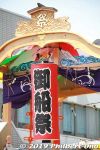
Hitachi-Otsu Ofune Matsuri fishing boat festival is Kita-Ibaraki's biggest festival, held only only once every five years on May 2 and 3 as the grand spring festival of Sawawachigi Shrine (佐波波地祇神社) in Otsu-cho, Kita-Ibaraki, Ibaraki PreHeld by local fishermen to pray for abundant fish and maritime safety. These photos were taken on May 3, 2019.
|
|
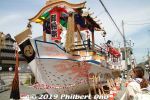
Unique Shinto festival where they drag a sacred fishing boat across land instead of water. The boat has no wheels. All other boat festivals have the boat sailing on water, but not this one.
|
|

On the May 2 festival eve, the boat is pulled from east to west along 1,200 meters in the center of town without the portable shrine aboard.
|
|
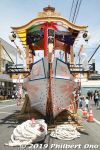
On the May 3 main festival day, the boat is dragged along the same route west to east with the portable shrine and shrine priests aboard.This boat is here at the start point on May 3, 2019.
|
|
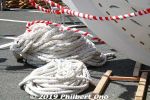
White ropes to pull the boat on the road.
|
|
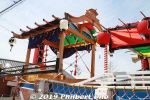
The bow has this shed for the portable shrine to be loaded on. Festival was designated as a National Important Intangible Folk Cultural Property (重要無形民俗文化財) in 2017.
|
|

Boat is 15 meters long, 4 meters wide, and weighs 5 tons. It becomes 2 tons heavier when the portable shrine (1 ton) and crew and musicians board.
|
|
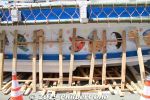
The ofune wooden fishing boat is painted with local fish.
|
|

My video of Kita-Ibaraki's Ofune Matsuri boat festival.
|
|
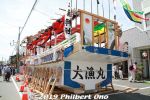
Back of ofune boat.
|
|
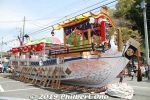
This festival was originally a portable shrine procession on the sea via boat going around the bay. But the boat's start point was filled in, so the boat procession was then held on land instead since 200 years ago.
|
|
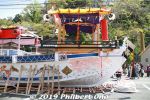
The festival started to be held every 5 years from 1975. The boat has to be repaired after each festival and the money could not be secured more often than every 5 years.The boat is normally displayed at a fishing museum named Yo-soro (よう・そろー) in Kita-Ibaraki.
|
|
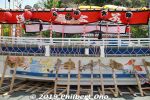
The festival used to be held by local fishermen, Now held by Hitachi-Otsu Ofune Matsuri Preservation Society (常陸大津の御船祭保存会) with most of the men being fishermen or their descendants.
|
|
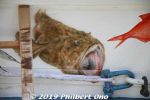
Paitning of a monkfish, a delicacy of Kita-Ibaraki.
|
|
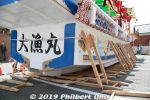
The boat rests on wooden pallets called "soroban." It is dragged on a bed of soroban pallets.
|
|
|
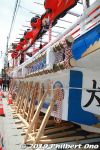
The festival originally used an actual fishing boat. But now this wooden boat was built especially for the festival.
|
|
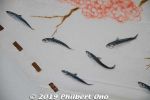
Sardines
|
|
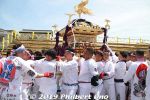
On May 3 from morning, they parade the mikoshi portable shrine bearing Sawawachigi Shrine's god for maritime safety.
|
|
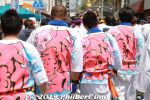
The festival participants belong to different fishermen's groups indicated by their shirt. They are from a group called Fudo-maru.
|
|
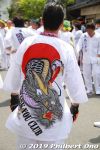
Thank You Club
|
|
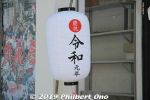
This was the first Ofune Matsuri to be held in the new era of Reiwa.
|
|
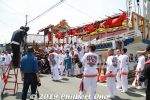
Group photos in front of the boat.
|
|
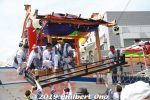
Removing in the boat railingsbefore people boarded.
|
|

Most boat musicians are local kids.
|
|
|
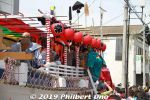
Boat musicians and crew board the boat via ladder.
|
|
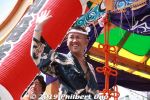
Looks like the boat captain.
|
|
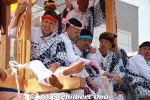
Boat crew waiting for the portable shrine to be loaded on the boat, which then becomes a "sacred boat."
|
|
|
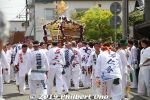
After being paraded around town all morning, the portable shrine arrives near the boat.
|
|
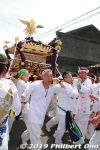
After being paraded around town all morning, the portable shrine arrives near the boat.
|
|
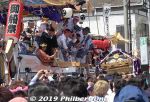
The boat crew welcome the portable shrine before it is loaded aboard.
|
|
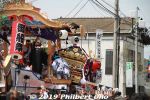
The portable shrine is loaded on the boat.
|
|
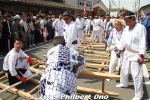
Ahead of the boat, wooden pallets called "soroban" are laid on the road for the boat to be dragged on.
|
|
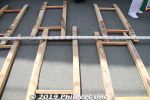
They use about 100 soroban wooden pallets (ソロバン) made of Japanese oak tree, a hard wood. Each weighs 20 kg.
|
|
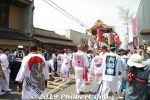
Before dragging the boat, they violently rock the boat side to side.
|
|
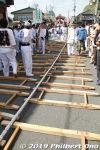
Boat is pulled by a 200-meter white rope, 7 cm thick. About 200 to 300 people pull the boat.
|
|
|
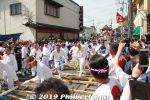
When dragging the boat, the men have to run over the wooden pallets and take care not to trip and fall.
|
|

They drag the boat 20 meters at a time. After each drag, they have to move and place the pallets ahead of the boat. The route is 1,200 meters long, and it takes 5 hours to reach the end.
|
|

Dragging the boat over the wooden pallets.
|
|

Ofune being dragged over wooden pallets.
|
|
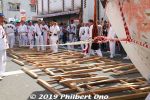
Pallets are ready for the next drag.
|
|
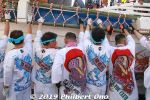
There are men on both sides of the boat who rock the boat before the drag. When the boat moves, they hang on to the boat.
|
|
|
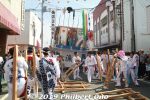
After the drag, they pick up the pallets and lay them in front of the boat on the road ahead.
|
|
|
|
|
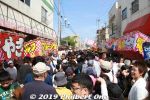
Narrow streets make it crowded.
|
|
|
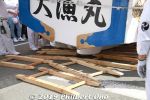
The boat hull has small center ridges that keep it standing upright. It's also designed not to topple over when rocked.
|
|
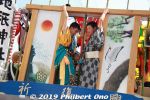
Three shrine priests are among the 40 people onboard. It's pretty rough to be rocked often. Motion sickness is possible.
|
|
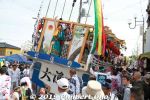
The boat is tilted to one side when it is dragged. It creates less friction and makes it easier to drag.
|
|
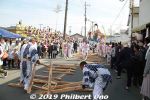
Picking up the pallets.
|
|
|
|
|
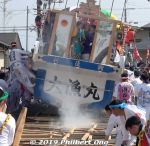
The friction between the boat hull and pallets makes it smoke each time the boat is dragged. The pallets are scorched.
|
|

The route has one 90-degree corner where the boat is turned. This is a festival highlight and many people crowd this corner.
|
|
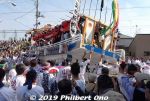
They turn the boat by dragging the stern of the boat. They had a rope tied to the rear part of the boat.
|
|
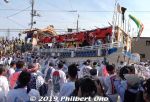
Turning the boat 90 degrees.
|
|

They turned the boat 90 degrees in one drag.
|
|
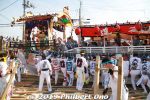
Getting ready for the rest of the straight route.
|
|
|
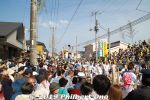
This corner is the most crowded spot. Many people leave after seeing this corner turn.
|
|
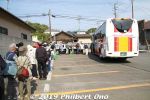
Shuttle bus back to JR Otsuko Station. Shuttle bus stop was near the start point a few hundred meters from the corner.
|
|
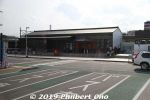
JR Otsuko Station
|
|
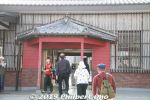
JR Otsuko Station has its entrance modeled after the Rokkakudo Pavilion on the Izura Coast.
|
|

JR Otsuko Station platform.
|
|
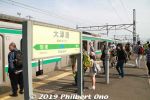
JR Otsuko Station platform.
|
|
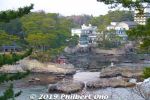
Kita-Ibaraki is a small, coastal city (pop. 42,000) with these picturesque cliffs of the Izura Coast (五浦海岸). Famous art scholar Okakura Tenshin (1863–1913 岡倉天心) found this scenic place to be a great inspiration for artists and moved here
|
|
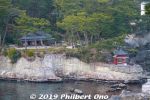
The small red pavilion is Izura Rokkakudo (五浦六角堂), the symbol of Kita-Ibaraki. Izura Rokkakudo was originally designed and built in 1905 by artist Okakura Tenshin (岡倉天心) as part of his residence. His house is on the left..
|
|
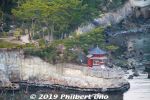
In Kita-Ibaraki, Tenshin used Rokkakudo to listen to ocean waves and gaze at the scenery. On March 11, 2011, it was washed away by the tsunami, but it was rebuilt in 2012.
|
|
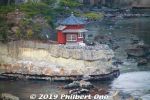
Izura Rokkakudo (五浦六角堂) is now being maintained by Ibaraki University and it continues to be a sacred spot for Japanese artists.
|
|
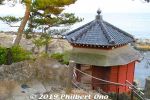
For a small admission fee, you can go down a path to see the Rokkakudo. (五浦六角堂).
|
|
|
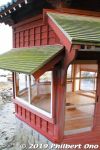
The glass windows were made in the UK.
|
|
|
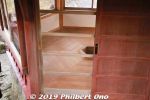
Must've been mesmerizing to pass time here. A place to attain artistic enlightenment.
|
|
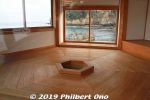
You cannot enter the Rokkakudo, but you can see inside through the glass windows made in the UK. There's supposed to be tatami mats inside.
|
|
|
|

About Rokkakudo.
|
|
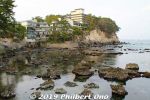
Scenery around Rokkakudo.
|
|
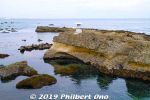
Scenery in front of Rokkakudo.
|
|
|
|
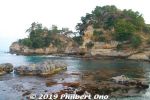
Artist-inspiring scenery around Rokkakudo, Kita-Ibaraki.
|
|
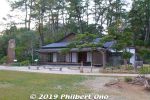
Tenshin's home on the Izura Coast, near the Rokkakudo Pavilion.
|
|
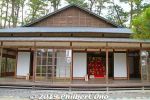
Tenshin's home on the Izura Coast, near the Rokkakudo Pavilion. Can't go inside.
|
|
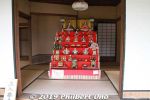
Hina dolls displayed inside Tenshin's home for Girl's Day (March 3).
|
|

About the Tenshin residence.
|
|
|
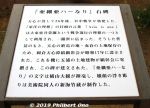
About the "Asia is One" monument.
|
|
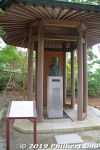
Along the path to Rokkakudo is this bust of Harvard professor and art historian Langdon Warner (1881–1955) who once studied under Tenshin and visited here. He is being revered here for supposedly helping to save Kyoto and Nara from World War II bombings
|
|
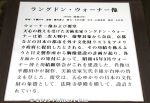
About Langdon Warner.
|
|
|

Izura Misaki Park on the coast.
|
|
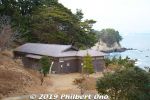
Prop for the movie "Tenshin."
|
|
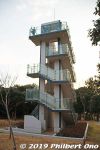
Izura Misaki Park has this lookout tower. 五浦岬公園 展望慰霊塔
|
|
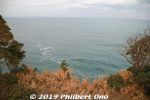
View from the lookout tower.
|
|
|
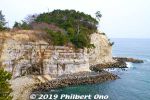
Izura Coast
|
|
|
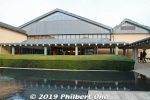
Tenshin Memorial Museum of Art, Ibaraki (茨城県天心記念 五浦美術館). Beautiful art museum in a beautiful place on the coast.
|
|
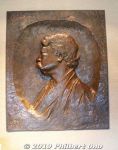
Tenshin Memorial Museum of Art was named after Okakura Tenshin (aka Okakura Kakuzo 1863–1913 岡倉天心/覚三), a famous art scholar and advocate of Japanese art, especially Nihonga paintings.In 1890, he was one of the founders and the first de facto dean of the forerunner of the Tokyo University of the Arts (Geidai), one of Japan's most prominent art universities.
|
|
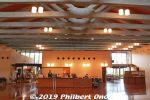
Lobby of Tenshin Memorial Museum of Art.Tenshin is revered in Kita-Ibaraki because he moved his Nihon Bijutsu-in artist group (Art Institute of Japan) here from Tokyo in 1906. His students, prominent Nihonga painters Yokoyama Taikan (1868–1958), Hishida Shunso (1874–1911), Shimomura Kanzan (1873–1930), and Kimura Buzan (1876–1942) followed him to this picturesque Izura Coast and built artist studio residences near Tenshin's home. The residences of Tenshin, Taikan, and Buzan still remain.
|
|
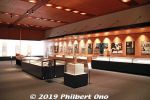
Tenshin Memorial Room explained the life and achievements of Tenshin. Founded Nihon Bijutsu-in (Art Institute of Japan) and moved it from Tokyo to Izura coast in Kita-Ibaraki in 1906.Includes exhibits about the time he worked at the Boston Museum of Fine Arts in 1910 in charge of the Chinese/Japanese art division.
|
|
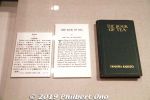
Tenshin was proficient in English and wrote the classic book, "The Book of Tea" in English.
|
|
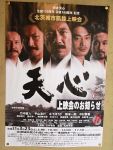
Movie poster for the movie, "Tenshin." It was being screened in the city.
|
|
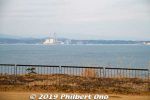
The museum has fine views of the ocean and southern coast of Fukushima (Iwaki). You may also notice a power plant in the distance. That's not the one that had a meltdown in 2011. It's the Nakoso Power Plant (勿来発電所), a thermal power plant (non-nuclear) operated by Joban Joint Power Co., Ltd.
|
|
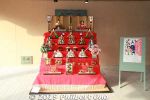
Hina Matsuri dolls displayed at the museum entrance.
|
|
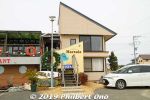
Marsala restaurant near the Izura Coast. マルサーラ
|
|
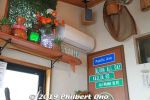
Marsala restaurant has Hawaiian decor.
|
|
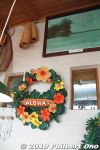
Marsala restaurant has Hawaiian decor, but no Hawaiian food. Only tropical drnks in summer.
|
|
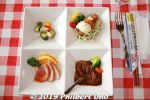
Appetizers. The food is good though.
|
|
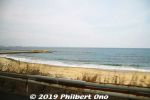
Kita-Ibaraki also has flat, sandy beaches.
|
|
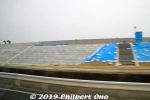
A sea wall being built. After 8 years, we hardly saw any other remnants of tsunami or quake damage.
|
|
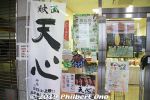
Tourist information center at JR Isohara Station.
|
|
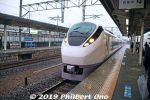
At JR Isohara Station, our tokkyu express train back to Ueno, Tokyo.
|
|
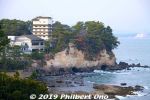
Near Rokkakudo Pavilion on the Izura coast is Itsuura Kanko Hotel (五浦観光ホテル), pictured here on the cliffs. This was our hotel for the night. It had prime views of the coast.The hotel was high enough on the cliff to escape the five-meter-high tsunami on March 11, 2011. The hotel suffered only minor damage from the earthquake. The ground is very solid here, so quake damage was minimal.
Note that the hotel's name is pronounced "Itsuura" while the coast is "Izura." (Kanji characters are the same.) izura.net
|
|

In the hotel lobby: Kita-Ibaraki's official mascots, An-chan and Kou-chan. Together, they are "Ankou" which means "monkfish," or angler fish that is the city's most famous delicacy. An-chan is a fisherman, and Kou-chan is a monkfish.
|
|
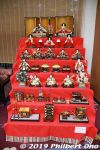
In the hotel lobby, Hina Matsuri dolls displayed for Girl's Day in early March.
|
|
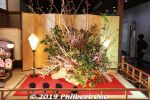
Lovely flowers in the hotel lobby.
|
|
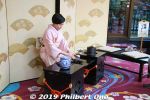
We arrived in the late afternoon in time for a tea ceremony in the hotel lobby. Conducted by the hotel's okami-san (proprietress 女将).
|
|
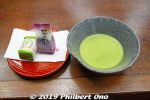
My complimentary matcha tea and confections.
|
|
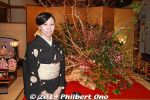
Itsuura Kanko Hotel's okami-san or proprietress (女将) speaks English. The hotel also has English-speaking staff.
|
|
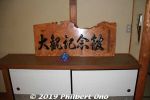
Itsuura Kanko Hotel is quite unique and historical because it renovated the artist residences of Nihonga painters Yokoyama Taikan and Kimura Buzan and uses them as part of the hotel where guests can stay. We actually stayed in the Yokoyama Taikan residence here. (横山大観記念館 特別室)
|
|
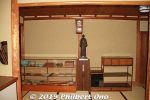
Entrance foyer of Yokoyama Taikan Memorial Hall where we stayed. Great private lodging for groups up to 22 people.
|
|
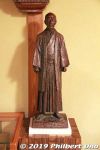
Statue of Yokoyama Taikan (横山大観), a very famous Japanese Nihonga painter. Taikan was born in Mito, the capital of Ibaraki. (横山大観)
|
|
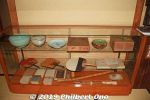
Yokoyama Taikan (1868–1958) is one of the most famous Nihonga painters. His former residence includes a showcase of his artifacts.
|
|
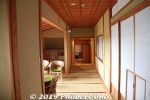
Main corridor inside Yokoyama Taikan Memorial Hall.
|
|
|
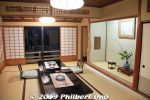
This used to be part of Yokoyama Taikan's living room, now one of the rooms where you can stay.
|
|
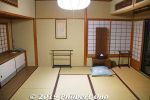
Another room of the living room.
|
|
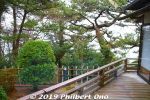
Outside the living room, a moon-viewing deck.
|
|
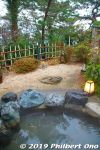
The Taikan house also has a small outdoor hot spring bath.
|
|
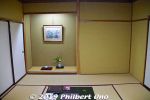
Another part of the Taikan house. Very aesthetic.
|
|
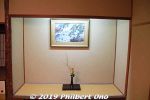
Beautiful tokonoma and painting.
|
|
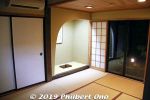
Taikan's residence is great for groups up to 22 people. It's a residence separate from the main hotel building so there's lots of privacy. Rates are very reasonable too. It was awesome to stay here.
|
|
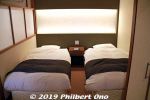
This is a typical room in the hotel's modern tower. Twin beds.
|
|

Typical room in the hotel's modern tower.
|
|
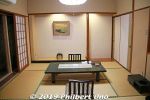
Typical room in the hotel's modern tower. This is the living room.
|
|
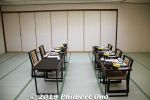
In the modern hotel tower, our banquet room for dinner.
|
|
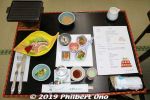
Appetizers for our full-course dinner.
|
|
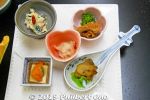
Appetizers.
|
|
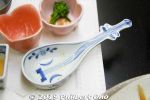
Biwa lute-shaped dish.
|
|
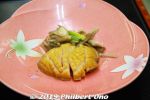
Abalone steak.
|
|
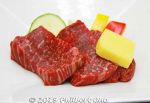
Local Hitachi Wagyu beef. ("Hitachi" is an old name for Ibaraki Prefecture. The famous electronics company Hitachi is also from Ibaraki.) 常陸牛
|
|
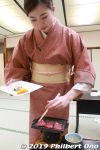
Hotel staff in kimono cooking my Hitachi Wagyu beef. 常陸牛
|
|
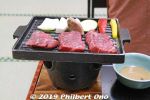
Hitachi Wagyu beef was just a small part of our dinner. We got really stuffed. 常陸牛
|
|
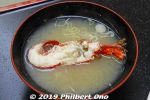
Lobster in miso soup.
|
|
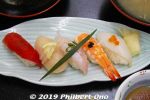
Sushi. Tuna, shrimp, ika squid, hotate scallop.
|
|
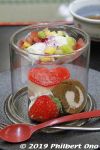
We were super stuffed, but there's always room for dessert...
|
|
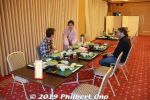
Next morning, breakfast in a large banquet hall.
|
|
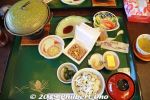
Breakfast included natto fermented soybeans. Ibaraki is famous for natto.
|
|
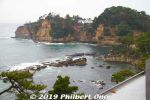
View from the hotel's modern tower.
|
|
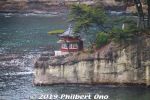
View of Rokkakudo from the hotel's modern tower.
|
|

Hotel gift shop.
|
|
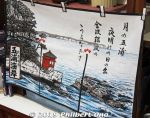
Hotel gift shop had this noren curtain with Rokkakudo design.
|
|
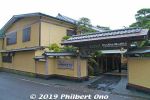
Another part of the Itsuura Kanko Hotel is the main wing (本館) which is the former artist residence of Kimura Buzan (木村武山), another famous Nihonga painter who followed Tenshin to Izura.
|
|
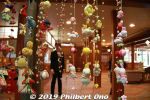
Lobby with Hina Matsuri decorations.
|
|
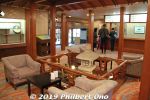
Itsuura Kanko Hotel Honkan lobby.
|
|
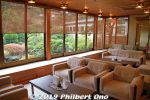
Itsuura Kanko Hotel Honkan lobby.
|
|
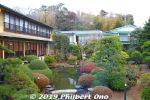
Courtyard garden of Buzan home.
|
|
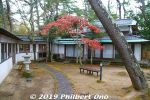
Different parts of the residence are connected by enclosed corridors.
|
|
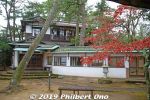
Part of the Buzan residence.
|
|
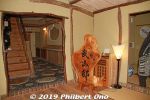
Entrance lobby of Kimura Buzan home. The wooden sign says "Buzan Residence." 武山邸
|
|
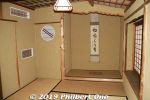
Buzan's beautiful tea ceremony room. Very chic. Available for rent for tea ceremonies.
|
|
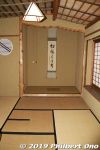
Buzan's beautiful tea ceremony room.
|
|

A large guest room. 武山邸客室
|
|
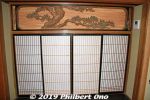
Elegant transom with a pine tree carving.
|
|
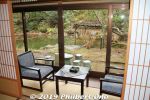
Relax here with a view.
|
|
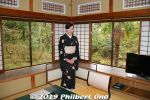
The okami-san posing in another guest room of the Buzan residence.
|
|
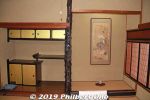
Tokonoma of another guest room. Many of the materials are quite rare and valuable today.
|
|
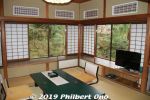
Corner room.
|
|
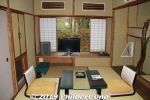
A smaller guest room.
|
|
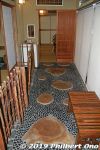
Corridor with pebbled floor leading to the outdoor bath.
|
|
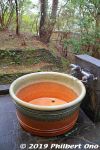
Outdoor bathtub made of Shigaraki-yaki pottery (from Shigaraki, Shiga Prefecture). The hotel has excellent taste in bathtubs. 信楽焼
|
|

Fancy corridor inside Kimura Buzan home.
|
|

Fancy corridor inside Kimura Buzan home.
|
|
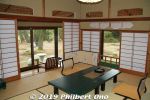
Large and private corner guest room inside Kimura Buzan home. It costs about ¥18,000 per person per night to stay here.
|
|
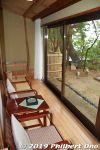
One of the most elegant Japanese-style hotels I've ever seen. Precious artwork everywhere. It's like staying in an art museum.
|
|
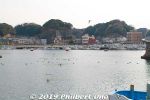
Hirakata Port is a major fishing port in Kita-Ibaraki.
|
|

Hirakata Port has a fish market that holds a fish auction in the afternoon. This is a typical wholesale fish market in Japan. Open-air, flat roof with a concrete floor next to fishing boats.
|
|
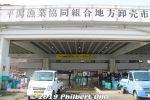
It's unlike the old Tsukiji fish market or the new Toyosu Market in Tokyo.
|
|
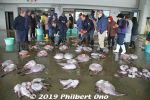
Hirakata Port's main catch is the monkfish/goosefish (あんこう), a type of anglerfish. Ibaraki Prefecture's coast is one of Japan's prime areas for monkfish. These are all monkfish being auctioned in the afternoon. 平潟港 せり見�
|
|

Monkfish/goosefish (あんこう), a type of anglerfish. They are most prized for their liver (ankimo), a local delicacy.
|
|
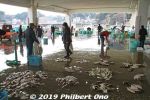
Besides monkfish, other fishes are sold at auction. This is not yet a tourist attraction since we were the only outsiders there.
|
|
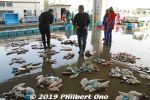
Each pile of fish is for a single bid.
|
|
|
|
|
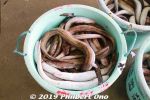
Sea eels or anago.
|
|
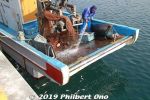
Cleaning up the fishing boat. Bycatch dumped overboard, but the birds are not picking it up.
|
|
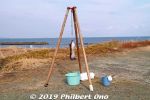
Oh look, something's hanging there...
|
|
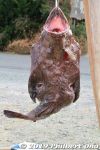
It's Kita-Ibaraki's famous fish and delicacy, monkfish, in the flesh. This one is 5 or 6 years old, weighing 12.7 kg. Only the female monkfish is eaten. The males are too small.あんこう
|
|
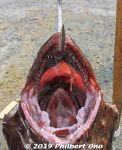
Look into the big mouth and see another set of teeth on the throat. All the teeth are pointed inward so its pray cannot escape. Like the aliens in the movie "Alien."
|
|
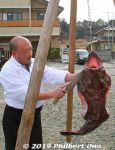
Monkfish being skinned and carved up by an expert chef. Since the monkfish is too slimy and slippery on a cutting board, it is hung like this for carving. It's a lot easier to cut up this way.He first takes off the skin (loaded with collagen).
|
|
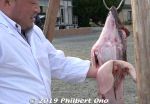
The chef is holding the liver (ankimo), the most prized part of the fish.
|
|
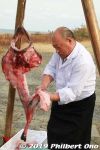
The white meat of monkfish.
|
|
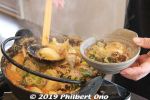
This is monkfish hot pot (dobojiru ankou-nabe) どぶ汁 with monkfish parts in a miso broth. I didn't have any problem eating it. The flavor was certainly not objectionable, it's just another kind of fish.It was already prepared for us and it wasn't the fish we saw carved.
|
|
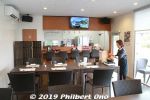
Akatsukien onsen minshuku dining room where we had monkfish hot pot. ¥14,000/night including dobujiru. 民宿 暁園
|
|
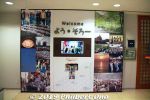
Yo-soro Fishing History Museum, 5 min. by taxi from JR Otsuko Station. Pretty large facility with local fishing-related exhibits. 北茨城市漁業歴史 資料館「よう・そろー」
|
|
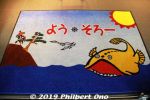
Welcome mat saying "Yo-soro" which means "Go ahead" for boat navigation.
|
|
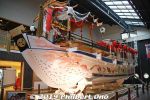
In Kita-Ibaraki, the Yo-soro Fishing History Museum's centerpiece exhibit is this wooden boat (祭事船) used in the Hitachi-Otsu Ofune Matsuri boat festival held every 5 years (常陸大津御船祭り).
|
|
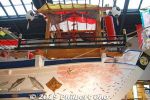
It's the city's grandest festival and very unique because this boat is pulled on city streets instead of sailing on the water.
|
|
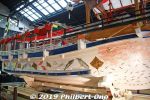
About 500 people drag this boat along a 1,200-meter route of paved streets. They lay wooden beams on the road for the boat to traverse on.
|
|

The boat, with shrine priests and musicians aboard, is rocked side to side as it is dragged on the street for several hours. This festival will be held on May 2nd–3rd, 2019. At least 160,000 spectators are expected to see it.
|
|

Short video of Hitachi-Otsu Ofune Matsuri boat festival.
|
|

The museum also has display panels showing the tsunami damage suffered by Kita-Ibaraki. Ibaraki Prefecture, being on the southern fringe of the Tohoku Region, suffered major earthquake and tsunami damage in March 2011.Kita-Ibaraki being closest to the Tohoku Region on the coast, suffered the most in Ibaraki Prefecture. The flat sandy beaches were overcome by the tsunami (second wave around 5 meters high) that caused much damage to Kita-Ibaraki. This is the Hirakata area after the tsunami. Besides major damage along the coast, the interior areas had numerous landslides, collapsed walls, and damaged roads due to the quake.
|
|

Ten people in Kita-Ibaraki died directly or indirectly due to the tsunami/earthquake and 186 injured. Over 8,000 homes in Kita-Ibaraki were damaged and up to 5,000 people had to evacuate to emergency shelters.These numbers pale in comparison to the three Tohoku prefectures, so Ibaraki doesn't get much attention with regard to 3-11, although the Emperor and Empress did visit Kita-Ibaraki in late April 2011.
|
|
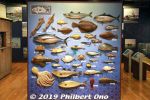
Display of all the fishes caught in Kita-Ibaraki.
|
|
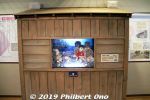
Yo-soro Museum also has this kami-shibai storytelling room. Story about British whalers who landed on Otsuhama beach in Kita-Ibaraki in May 1824 in search of food and water.It was during the time Japan largely prohibited contact with foreigners. By the 1800s, whaling ships from the West were frequently seen off the coast of Japan. In May 1824, multiple British whaling ships appeared off the coast of Kita-Ibaraki.
|
|
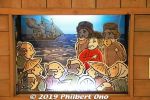
The crew suffered from scurvy due to the lack of vitamin C. They needed water and vegetables so 12 British whalers landed on Otsuhama beach in Kita-Ibaraki. They were willing to barter guns, spears, gold, etc., as payment. (大津浜事件)
|
|
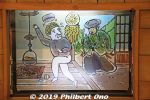
However, the 12 whalers were instead held captive by the local samurai. They were tied to plum trees or confined to caves. More British ships arrived seeking the release of the prisoners.Also, the Mito Clan also brought in neighboring clans like the Taira Clan as reinforcement for a potential battle. Cannons were pointed at each other, but a conflict was averted by giving the whalers the water and food that sent them along their way away from Japan. In return, the whalers gave guns, spears, felt, gold, and silver as payment and had to promise not to approach Japan again.
|
|
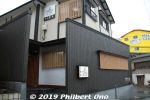
Onsen Minshuku Uohiko lodge near Hirakata Port. Ankou-nabe is a specialty. Recently renovated. 温泉民宿 魚彦
|
|
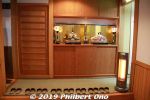
Minshuku Uohiko uses natural hot spring for the bath.
|
|
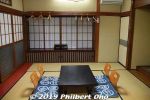
Standard size room in Minshuku Uohiko.
|
|
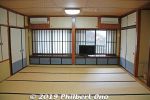
Large room in Minshuku Uohiko.
|
|
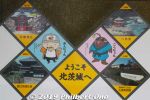
JR Isohara Station welcome sign.
|
|

An-chan and Kou-chan mascots in Aloha shirts.
|
|
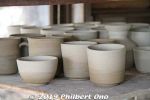
Local pottery called Izura Tenshin-yaki started about 25 years ago by the local Chamber of Commerce. Clay called "gairome" (蛙目) found locally is used. The clay is found in this area under the coal deposits. They collect the clay already exposed on the ground (no digging). This type of clay contains quartz, but the large quartz pieces are removed for pottery.
|
|
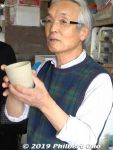
This is Kikuchi Hidetoshi, a local potter who, along with his wife Mie, taught us how to make Izura Tenshin-yaki pottery (五浦天心焼). They moved here in 1998.The Kikuchis are one of several Tenshin-yaki potters in Kita-Ibaraki.
|
|
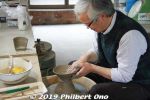
We visited his modest studio for a hands-on pottery lesson. First he demonstrated what we have to do. He made it look so quick and easy. 土の夢陶房 (菊池 秀利・美恵)
|
|
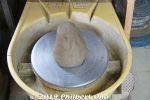
We each got a clump of clay, enough to make several cups or bowls.
|
|
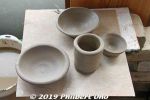
From one clump of clay, I made all these pieces. Oh yeah, it's easy. Anybody can do it. It costs a few thousand yen per piece to color and fire. It is sent to us later.
|
|
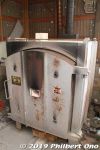
Kiln is in a another small building.
|
|
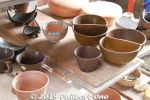
Kikuchi's pottery.
|
|

We were treated to refreshments served in the Kikuchis' pottery. Confection of azuki bean soup with a piece of mochi. Thank you to Hidetoshi and Mie Kikuchi (菊池 秀利・美恵) for teaching us pottery and hosting us in their beautiful, Japanese-
|
|
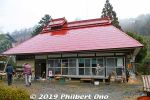
Former farmhouse converted into an artist's studio and gallery called "Arigatee" (pronounced "Ariga-tay" ありがてえ). It means "thankful" (arigatai) in the local dialect. It's also named after the former owner
|
|
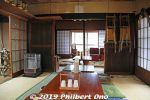
Arigatee is 150 years old built in the late Edo Period. This house will be accepting artist-in-residence as well.
|
|

Arigatee's current caretaker is Ishiwata Norio and his wife Chifumi (石渡のりお・ちふみ). They moved here from Tokyo. He uses it as a artist studio. That's his painting on the wall.Kita-Ibaraki is promoting itself as an art city, and Arigatee is part of the project. Ishiwata-san and his wife were very gracious and a real boon to the city's artist community.
|
|
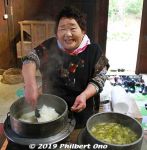
At Arigatee, we were charmed by the delightful Sumi-chan, a retired local farmer. She helped cook our lunch. Rice locally grown in Kita-Ibaraki. Thank you Sumi-chan for smiling!
|
|
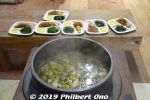
The miso soybean paste in the tonjiru pork miso soup was made by Sumi-chan, a "miso meijin" (味噌名人) or expert miso cook.
|
|

Ishiwata Chifumi and Sumi-chan.
|
|

Our table for lunch in the main room of Arigatee.
|
|
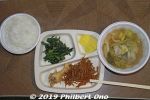
Our lunch at Arigatee. Chicken drumstick, vegetables, rice, and tonjiru (pork and vegetables) soup.
|
|
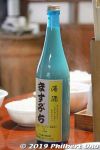
Local sake, a type called Doboroku (どぶろく) or nigori-zake (濁り酒). It's thick and cloudy-white. Sour taste. Made by a local brewer and restaurant named Masubuchi (増渕魚園).
|
|
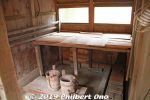
Former horse stable.
|
|
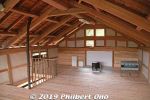
Former horse stable's attic will become a gallery space.
|
|
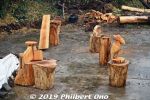
Chain saw sculptures.
|
|
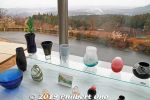
Silica Glass Museum is on a hill with great views of the city. Also offers hands-on glass-making lessons. http://www.studiosilica.com/
|
|
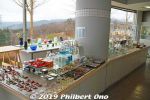
Glass Studio Silica gift shop. ガラス工房シリカ
|
|
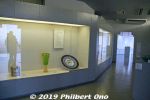
Glass Studio Silica main exhibition room. ガラス工房シリカ
|
|
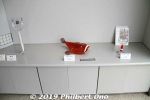
Glass Studio Silica with a glass sculpture of monkfish.
|
|
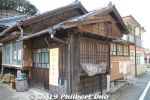
Gallery Salamat Po. "Salamat Po" means "Thank you" in Tagalog. (ぎゃらりー さらま・ぽ) (ぎゃらりー さらま・ぽ)
|
|
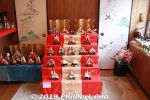
The gallery had Hina dolls for Girl's Day.
|
|
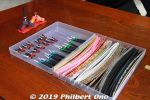
They taught us how to make Hina ningyo dolls for Girl's Day (March 3). We could pick any of these plastic pins and decorative bands for our Hina dolls. Yes, that's all we needed to make the dolls.
|
|
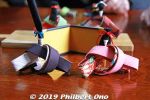
Very simple to make. Tie the two bands into a knot, then stick the head (pin) into it. Did it in 2 minutes. Prince on the left, princess on the right.
|
|
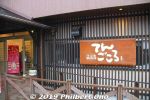
Tengokoro, for local gifts and products. てんごころ http://www.tengokoro.com/
|
|
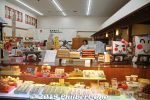
Inside Tengokoro.
|
|
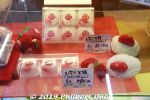
Strawberry daifuku is a specialty of Kita-Ibaraki. Made with locally-grown strawberries. Ibaraki is also a major producer of melons in Japan.
|
|

An-chan on a cup of sake.
|
|
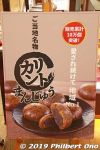
Karinto manju.
|
|
|
|